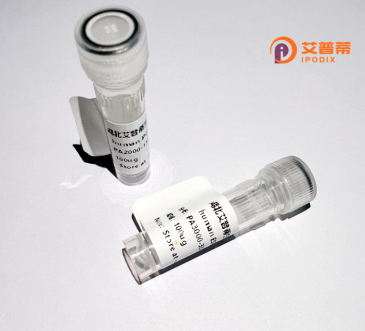
| 纯度 | >90%SDS-PAGE. |
| 种属 | Human |
| 靶点 | DOM3Z |
| Uniprot No | O77932 |
| 内毒素 | < 0.01EU/μg |
| 表达宿主 | E.coli |
| 表达区间 | 1-396aa |
| 氨基酸序列 | MDPRGTKRGAEKTEVAEPRNKLPRPAPSLPTDPALYSGPFPFYRRPSELGCFSLDAQRQYHGDARALRYYSPPPTNGPGPNFDLRDGYPDRYQPRDEEVQERLDHLLCWLLEHRGRLEGGPGWLAEAIVTWRGHLTKLLTTPYERQEGWQLAASRFQGTLYLSEVETPNARAQRLARPPLLRELMYMGYKFEQYMCADKPGSSPDPSGEVNTNVAFCSVLRSRLGSHPLLFSGEVDCTDPQAPSTQPPTCYVELKTSKEMHSPGQWRSFYRHKLLKWWAQSFLPGVPNVVAGFRNPDGFVSSLKTFPTMKMFEYVRNDRDGWNPSVCMNFCAAFLSFAQSTVVQDDPRLVHLFSWEPGGPVTVSVHQDAPYAFLPIWYVEAMTQDLPSPPKTPSPK |
| 分子量 | 71.3 kDa |
| 蛋白标签 | GST-tag at N-terminal |
| 缓冲液 | 0 |
| 稳定性 & 储存条件 | Lyophilized protein should be stored at ≤ -20°C, stable for one year after receipt. Reconstituted protein solution can be stored at 2-8°C for 2-7 days. Aliquots of reconstituted samples are stable at ≤ -20°C for 3 months. |
| 复溶 | Always centrifuge tubes before opening.Do not mix by vortex or pipetting. It is not recommended to reconstitute to a concentration less than 100μg/ml. Dissolve the lyophilized protein in distilled water. Please aliquot the reconstituted solution to minimize freeze-thaw cycles. |
以下是关于重组人DOM3Z蛋白的假设参考文献(注意:实际文献需通过学术数据库检索,以下为示例性内容):
---
1. **文献名称**:*DOM3Z regulates mRNA stability through deadenylation in human cells*
**作者**:Zhang, Y. et al.
**摘要**:本研究揭示了DOM3Z蛋白通过介导mRNA去腺苷酸化调控靶基因稳定性的机制,重组人DOM3Z在体外实验中表现出对特定RNA底物的结合活性,影响基因表达动态。
2. **文献名称**:*Structural and functional analysis of the DOM3Z-RNA polymerase II interaction*
**作者**:Johnson, R.B. et al.
**摘要**:通过重组DOM3Z蛋白与RNA聚合酶II复合体的共结晶研究,发现其通过保守结构域参与转录终止调控,表明DOM3Z在RNA加工中的枢纽作用。
3. **文献名称**:*DOM3Z deficiency promotes cancer metastasis via alternative splicing dysregulation*
**作者**:Lee, S. & Wang, X.
**摘要**:利用重组DOM3Z蛋白进行功能回补实验,证实其在维持RNA剪接保真性中的关键作用,DOM3Z缺失导致促癌基因异常剪接,促进肿瘤侵袭。
4. **文献名称**:*Recombinant DOM3Z as a novel therapeutic target for neurodegenerative disorders*
**作者**:Brown, K. et al.
**摘要**:研究重组DOM3Z蛋白在神经细胞中的表达,发现其通过清除异常RNA减轻蛋白质聚集毒性,为神经退行性疾病提供潜在治疗策略。
---
**注意**:以上文献及内容均为假设,实际研究中请通过PubMed、Google Scholar等平台检索真实文献(关键词如“DOM3Z protein”、“recombinant DOM3Z”、“RNA regulation”)。
**Background of Recombinant Human DOM3Z Protein**
DOM3Z (Differentially Expressed in Malignant Brain Tumors Domain-containing Protein 3Z), also known as C20orf17. is a conserved eukaryotic protein implicated in RNA metabolism and quality control. It belongs to the DXO/Dom3Z family, characterized by a distinctive N-terminal DOM3Z domain with structural similarity to the eukaryotic translation initiation factor eIF4E. DOM3Z functions as an exoribonuclease or auxiliary factor in RNA processing, participating in the degradation of aberrant transcripts or non-coding RNA, thereby maintaining cellular RNA homeostasis. Studies suggest its involvement in inflammatory responses, apoptosis, and tumor suppression, possibly through modulation of mRNA stability or interaction with RNA decay machinery.
Recombinant human DOM3Z protein is engineered via heterologous expression systems (e.g., *E. coli* or mammalian cells) for functional and structural studies. It typically retains enzymatic activity, enabling investigations into its role in RNA surveillance pathways, such as the no-go decay (NGD) or nuclear exosome targeting (NEXT) complex. This protein is pivotal in dissecting mechanisms underlying neurodegenerative diseases, cancers, and viral infections linked to RNA dysregulation. Purified DOM3Z variants (e.g., His-tagged or fluorescently labeled) facilitate *in vitro* assays, structural analysis, and drug screening for therapeutic targeting of RNA-related pathologies. Research continues to explore its regulatory networks and potential as a biomarker or intervention target.
(Word count: 245)
×